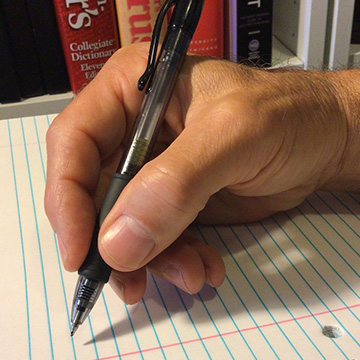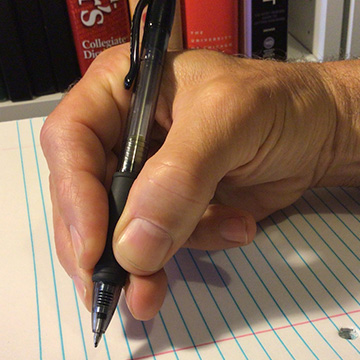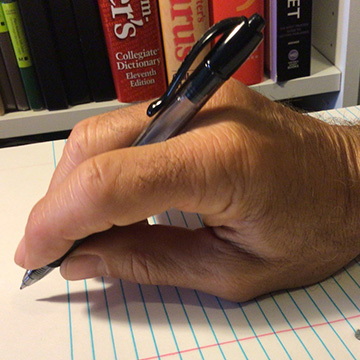One of my most enduring early writing lessons was simply how to hold a pen.
It seems almost too basic and obvious even to mention. We’ve been holding pens (and pencils) since childhood. Improving your writing should be about style, diction, organizing one’s ideas, expressing lofty things—right?
Grappling with words on a page brings its own exquisite sort of agony. I don’t mind that; it’s part of the joy and challenge of writing.

But the act of writing shouldn’t cause physical pain. Not only does my hand not hurt any more, but changing my pen grip also changed my relationship to writing itself. How can writing be a joy when your hand hurts?
My conversion happened simply. A coworker took one look at the tight, clenched attitude of my right hand and said, basically, “Your hand must hurt. Wanna see an easier way?”
Today, decades later, if I start writing with a traditional grip, I physically can’t stand it for more than a minute. It’s too uncomfortable. I have to switch to the way I learned that day.
Today I’m sharing that way with you.
The Dis-Ease of Writing
I hear lots of reasons why people don’t write — why they don’t do the writing they’ve told themselves they want or need to do for business, blogging, self-expression, or something else.
What I discovered all those years ago was that the physical discomfort of writing itself can be one of the reasons. A reason you probably didn’t realize was there, because you’ve been holding pens all your life.
Once I changed my grip, writing became physically easier, so I wrote more. It didn’t improve my writing per se, but the more words I wrote, the more writing practice I got, and the more I improved through practice.
How Most People Hold a Pen
The way we most often learn is to grip a pen with three fingertips (thumb and two fingers) and rest the pen on the “first web” — the pad of muscle between the thumb and index finger (Image #1). The third and fourth fingers rest on the page, stabilizing the hand while writing.
There are recognized variations, and of course individual ones, and left-handers need to position their hand or the paper differently so they can a) see what they’re writing, and b) not smudge the ink.

My own variation was to add my third finger into the grip (Image #2), thereby exerting (and exhausting) even more muscles to grasp the pen even tighter.
The Trick, Revealed
The trick is to reverse where you grip. What my coworker showed me was how to grasp the pen at the hand so the fingertips merely guide.
The hand doesn’t need to grip at all. Lay the middle of the pen between the bases of the index and middle fingers (“second web”) and it’ll stay there because the fingers are so close together.
The fingers and thumb can then easily curve down to rest near the pen tip, where they simply guide it (Image #3).
In contrast to my original grip — or any grip for that matter — this way of holding a pen requires no muscular effort whatsoever. Guiding the tip requires next to none; or none if you drive the writing action with your arm, instead of the fingers and wrist, which tire more easily.
It took some getting used to. But like I said, this “grip” (I can hardly call it that now) is so much easier that today I can’t even write the old way for more than a minute.
The Key Difference
We live in an age of keyboards.

For all the range of new input devices — mouses, scrolling devices, touch pads, tablet pens, etc. — our primary interface with technology is the keyboard, the alphabet.
I learned my lesson when keyboards were few and pens were the main option besides typewriters. And yet, in 2023 the market outlook for ballpoint pens remains as bright as ever. We’re still writing plenty by hand.
We tilt our keyboards and position our pointing devices to prevent carpal tunnel syndrome, shoulder pain, and other ergonomically avoidable ailments.
And yet we take no such care with our pens. We still grip them until our hands hurt.
Don’t Get a Grip
Relaxing your writing hand can prevent chronic pain or worse in your fingers, hand, wrist, arm, and shoulders. The health benefits of that should speak for themselves.
The creative benefits are less obvious but no less real and enduring.
You may have a lot of perfectly understandable psychological reasons for not doing the blogging or other writing you want to be doing.
But you’ll never feel like writing if it’s physically uncomfortable to write.
You'll never feel like writing if it's physically uncomfortable to write.Click To TweetSo start there, with the simple, tangible situation at the end of your arm. You may try my grip and decide you still prefer your current way. Do whatever works.
My point is not change, but mindfulness. Maybe you’ll keep your current grip but relax it a little. If for no other reason, do it for your health.
You and your writing can then feel free to go with the flow.
How do you hold a pen? Share your thoughts in the comments below.
